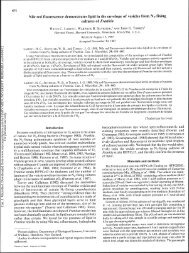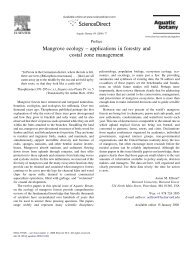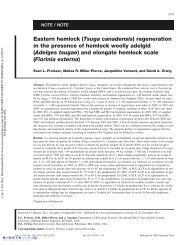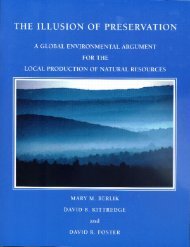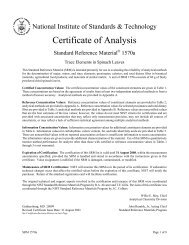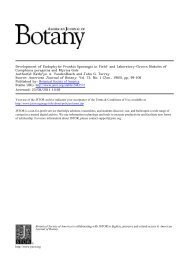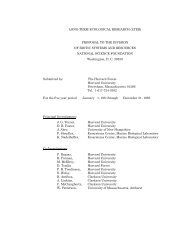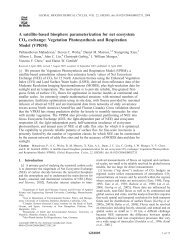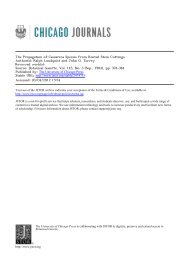Abstracts of Papers - Harvard Forest - Harvard University
Abstracts of Papers - Harvard Forest - Harvard University
Abstracts of Papers - Harvard Forest - Harvard University
Create successful ePaper yourself
Turn your PDF publications into a flip-book with our unique Google optimized e-Paper software.
degree <strong>of</strong> variability within each population was,<br />
large and for most characters the mean values, and<br />
the variance, decreased with increasing pasture age.<br />
It is argued that the overall high diversity has<br />
resulted from the heterogeneity <strong>of</strong> the biotic<br />
environment, and the general decrease in diversity is<br />
attributable to continuous elimination <strong>of</strong> the less<br />
fit genotypes by competition and grazing.<br />
ACKERMAN, JAMES D.* ana ARLEE M. MONTALVO.<br />
Department <strong>of</strong> Biology, <strong>University</strong> <strong>of</strong> Puerto RicQ,<br />
Rio Piedras, PR 00931. -- Limitations to natural<br />
fruit production in Epiaend-rum ciliare, a tropical<br />
orchid.<br />
Natural fruit set <strong>of</strong> Epidendxrum ciliare (Orchidaceae)<br />
at one large population in Puerto Rico was 6 %<br />
during the first <strong>of</strong> two flowering seasons studied.<br />
The flowers are allogamous ana self-compatible.<br />
They lack pollen anda nectar rewards. In the second<br />
season, handa-pollinated<br />
more fruits (74k % fruit<br />
plaxits produced substaxntially<br />
set) than control groups<br />
(13 %), which suggests that the paucity <strong>of</strong> pollinations<br />
is one factor limiting natural fruit production<br />
at this population. However, other constraints are<br />
likely operating as well. Correlation anaalysis shows<br />
that large inflorescences have a higher percent fruit<br />
set than small inflorescences, yet most inflorescences<br />
are small. Thus, factors affecting the vigor<br />
<strong>of</strong> a planat may also contribute to the low fruit<br />
production <strong>of</strong> this species.<br />
ADAMS, JILL D. Department <strong>of</strong> Botany, <strong>University</strong><br />
<strong>of</strong> Washington, and MILTON SMITH. College <strong>of</strong><br />
<strong>Forest</strong> Resources, <strong>University</strong> <strong>of</strong> Washington,<br />
Seattle, WA 98195.<br />
- Using LANDSAT images to study plant<br />
A case in Hawaii.<br />
succession:<br />
LANDSAT images have been used for rapidly defining<br />
and classifying successional sequences on the lava<br />
flows <strong>of</strong> Mauna Loa, Hawaii. Mauna Loa, a shield-type<br />
volcano (elevation<br />
recorded ages that<br />
13,680<br />
extend<br />
feet), has flows <strong>of</strong> various<br />
from high elevations to sea<br />
level on both the wet and dry sides <strong>of</strong> the Island <strong>of</strong><br />
Hawaii.<br />
primarily<br />
Successional patterns on the flows<br />
on the roughness <strong>of</strong> the substrate,<br />
depend<br />
the<br />
rainfall, and the elevation. The rougher aa flows<br />
have slower vegetation development than the smoother<br />
pahoehoe flows in all except the wettest regions. In<br />
addition, succession<br />
fern sparse forest,<br />
on aa <strong>of</strong>ten leads to an Ohia/<br />
whereas pahoehoe flows <strong>of</strong> the<br />
same age and aspect will give rise to savannah and<br />
mixed Koa forest. On a given flow succession proceeds<br />
more slowly at higher elevations, thus it is<br />
<strong>of</strong>ten possible to observe a range <strong>of</strong> successional<br />
stages by examining the changes occuring in the<br />
LANDSAT spectral<br />
<strong>of</strong> the flow.<br />
signature from the top to the base<br />
ANTLFINGER, ANN E. Biology Department,<br />
<strong>University</strong> <strong>of</strong> Nebraska at Omaha, Omaha, NE 68182.<br />
- The genetic and ecological consequences <strong>of</strong><br />
outcrossing in Impatiens capensis.<br />
Because genetic transmission occurs through the<br />
process <strong>of</strong> mating, a plant's mating system has signi-<br />
ficant effects on the genotypic structure and the<br />
dynamics <strong>of</strong> evolutionary change <strong>of</strong> plant populations.<br />
The mixed mating system <strong>of</strong> Impatiens capensis takes<br />
the form <strong>of</strong> floral dimorphism where chasmogamous and<br />
cleistogamous flowers are produced on the s-ame indi-<br />
vidual. To estimate the fitness <strong>of</strong> cleistogamous<br />
Ecological Section 43<br />
(CL) and chasmogamous (CH) individuals, germination,<br />
growth and survival <strong>of</strong> seedlings in field and green-<br />
house populations were compared. Mean percent field<br />
germination for spring, 1982, was 63.4 for CL seeds<br />
and 39.8 for CH seeds. CH seedlings were larger in<br />
size than CL seedlings. However, under uniform<br />
greenhouse conditions, growth rates were similar in<br />
both mating types. These experiments were repeated<br />
with seeds germinated in spring, 1983. Genetic<br />
variation was assessed using starch gel electrophore-<br />
sis and family-structured common garden experiments.<br />
ARMBRUSTER, W. SCOTT. Department <strong>of</strong> Biology,<br />
<strong>University</strong> <strong>of</strong> Alaska, Fairbanks, AK 99701.<br />
- Phenological Organization and Pollination<br />
Ecology <strong>of</strong> the Plant Communities on South-facing<br />
bluffs in the Subarctic.<br />
Flowering phenology and plant-pollinator relationships<br />
were observed on a series <strong>of</strong> south-facing bluffs in<br />
interior Alaska. The communities comprise a distinctive<br />
assemblage <strong>of</strong> plant and insect sp-ecies; many <strong>of</strong> the<br />
species are endemics, disjuncts, or vicariants <strong>of</strong> taxa<br />
<strong>of</strong> temperate North America or Asia. The major<br />
pollinators <strong>of</strong> the zoophilous flora include solitary<br />
bees (Andrenidae, Halictidae, Megachildae, Anthophoridae),<br />
Bombus (Apidae), and bee flies<br />
(Bombyliidae). Three functional flower classes were<br />
distinguished: open flowers, short-tube flowers, and<br />
long-tube flowers. Each class has a characteristic<br />
assemblage <strong>of</strong> pollinators. Overlap <strong>of</strong> flowering period<br />
among members <strong>of</strong> the same flower class was measured and<br />
compared with the overlap among members <strong>of</strong> different<br />
flower classes. Members <strong>of</strong> the open and short-tube<br />
flower classes had significantly less overlap than the<br />
null expectation, whereas long-tube flowers had more<br />
overlap. This difference may be a consequence <strong>of</strong> the<br />
fact that members <strong>of</strong> the open and short-tube classes<br />
share locations <strong>of</strong> pollen placement on pollinators with<br />
members <strong>of</strong> their own class, whereas long-tube species<br />
place pollen in 2-3 distinct locations on the<br />
pollinators' bodies.<br />
BASKIN, CAROL C.* and JERRY M. BASKIN. School<br />
<strong>of</strong> Biological Sciences, <strong>University</strong> <strong>of</strong> Kentucky,<br />
Lexington, KY 40506. - Germination ecophysi-<br />
ology <strong>of</strong> eastern deciduous forest herbs:<br />
Stylophorum diphyllum.<br />
Stylophorum diphyllum is an herbaceous perennial<br />
<strong>of</strong> mesic deciduous forests in the eastern USAo<br />
Seeds are dorrnant at dispersal in spring, and<br />
dormancy is due to a rudimentary embryo which<br />
requires incubation at low moist temperatures<br />
f or growth. In nature embryo elongation occurs<br />
during the cold season, and seeds germinate in<br />
early spring. A warm pretreatment is not re-<br />
quired for subsequent embryo growth and germ-<br />
ination. Embryos in freshly-matured seeds<br />
averaged 0.41 mm long, but after 10 w <strong>of</strong><br />
chilling at 5 C they averaged 1.41 mm. Germ-<br />
ination <strong>of</strong> seeds incubated continuously at 5 C<br />
began after 11 w; after 19 w 80?% had germinated.<br />
Seeds chilled for 6 w germinated to 75 and 65?h<br />
at daily thermoperiods <strong>of</strong> 15/6 and 20/10 C,<br />
respectively, while 12 w <strong>of</strong> chilling were re-<br />
quired for comparable germination at 25/15 C.<br />
Seeds <strong>of</strong> S. diphyllum fit Nikolaeva's (1977)<br />
definition omrpophysiologica). complex<br />
dormancy .




